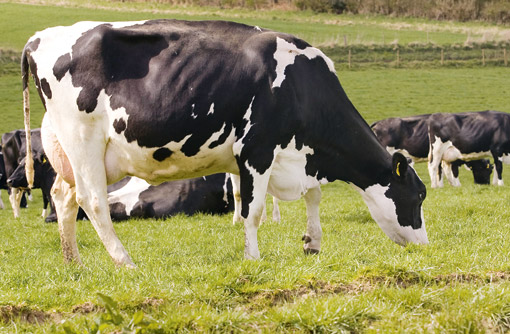Grazed grass vital in a balanced dairy ration

Factoring in grazed grass as part of a complete, balanced ration is fundamental to ensuring efficient use at turnout, believes Kent producer William Westacott.
Such is his conviction, that the term “buffer” is a dirty word at his farm in Sevenoaks, Kent.
“I hate the phrase buffer feed, because it sounds like an excuse,” said Mr Westacott at a recent milking grass for profit farm walk held by the Royal Association of British Dairy Farmers, the British Grassland Society and DairyCo.
“The aim is to have a balanced ration, including grazed grass,” Mr Westacott added.
Mr Westacott and herd manager Richard Evans are strongly committed to maximising production, not only from home produced forage, but also from bought-in feed.
What makes their system unusual is the fact they are managing a herd of 9,800 litre, autumn block calving Holsteins. Although fertility pressures are not as high at turn-out because the 170 cows are pregnant, animals are still producing about 35 litres, so maintaining yields is crucial.
“We have a high-yielding herd and the aim is to turnout a 200-day calved cow and challenge her as much as possible at grass,” explained Mr Westacott.
“We set the cow up for high production on a TMR and then convert her as best possible to a grazing cow.”
DairyCo Milk Bench figures show although Home Farm is buying in roughly 400kg more feed a cow a year, they are achieving 2,000 litres a cow more a year than the top 10% of producers, showing they are using feed effectively.
“The aim is to have a balanced ration, including grazed grass.”
William Westacott
Mr Evans calculates it costs £4.93 a cow a day in feed and labour costs when cows are housed through the winter. However, by managing grass effectively and turning out, significant savings can be made.
“Conserved forage costs 10-10.5p/kg DM, where as grazed grass costs 5p/kg DM,” he said.
In 2009 the farm started by grazing and back fencing four to five large fields, however they quickly realised they were losing out on potential profit by not getting the most from grass protein.
The following year they moved to paddock grazing, working on a 21-22 day rotation, using a grass plate meter to monitor and manage grazing.
Despite an initial two litre a cow milk drop at turnout last season the savings in feed, labour and housing costs equated to £15,000 over the 120 day grazing period or a 1p/litre net margin over milk produced.
This year, they admit things have been more challenging, with stunted grass growth delaying turnout by three weeks already. “We’ve had to buy in straw and feed, which is costing us £800-£1,000 a week. We need to get them out,” said Mr Evans.
“We’ve actually seen kilos of dry matter of grass go back in some paddocks. On 11 April last year average cover was 2,246kg DM/ha with grass growth of 45kg DM/day. At the moment the grazing platform is just above residual, so we can’t afford to turn cows out.”
They aim for cows to go into covers of 2,700kg DM/ha and graze down to a residual of 1,600-1,650kg DM/ha.
“Some say to graze to a residual of 1,400-1,500, but we see this as controlled starvation – 1,600-1,650 is our aim. Cows are still pushing out 35 litres when we turnout so this residual is not detrimental to milk yields.”
Mr Westacott believes any cow can graze, it’s just about making sure intakes are balanced and set to achieve requirements. “Our cows couldn’t eat 25kg of grazed grass to maintain yields,” he said. “We set them up in the shed and then balance the ration when they’re at grass.”
Cows do not receive supplementary feeding after morning milking so they go out with an edge on appetite to fresh pasture.
The farm can dry out in a normal year, however, because cow numbers are reducing through the grazing period as they are dried off, grass growth rates can reduce without the need for additional fertiliser costs, said Mr Evans.
“We start calving in a 20-week period starting at the end of August and we’ll start drying off in groups around the end of June.”
Mr Evans believes the key to successful grazing is understanding what grass can deliver. “Don’t guesstimate grass – you need to actually measure.
“If you’ve got hard data in front of you can decide what grass can provide and how to alter rotation length.”
Read more on the latest feed markets on our Feed Watch page
